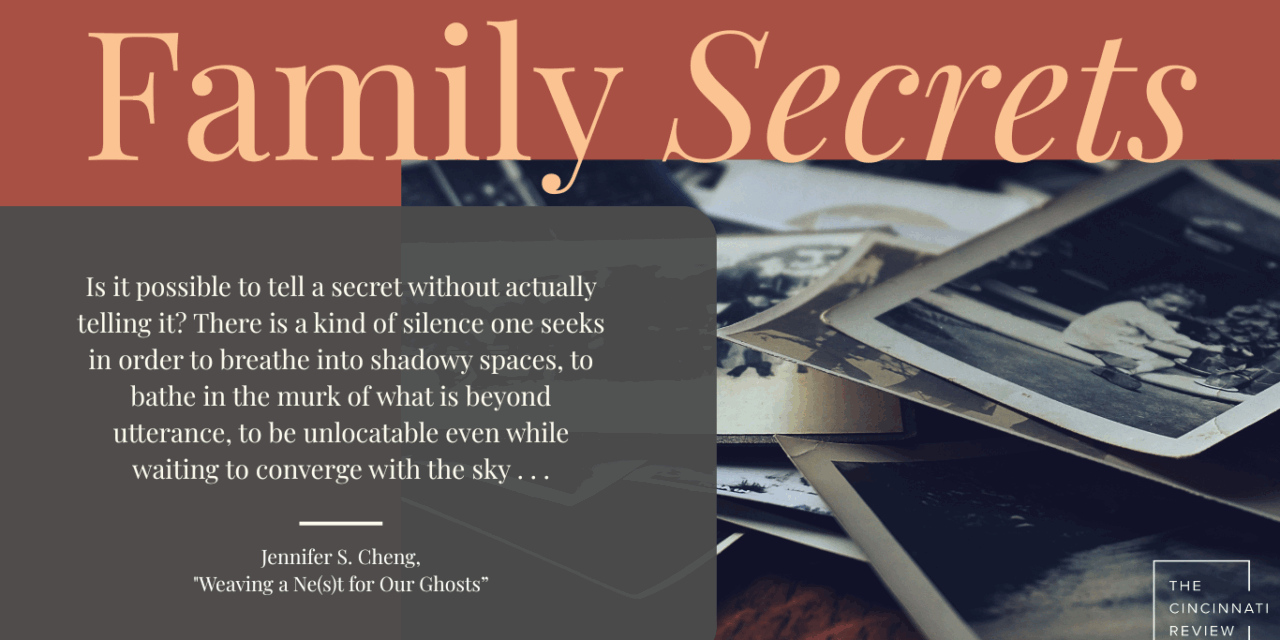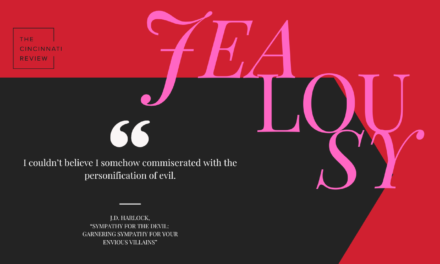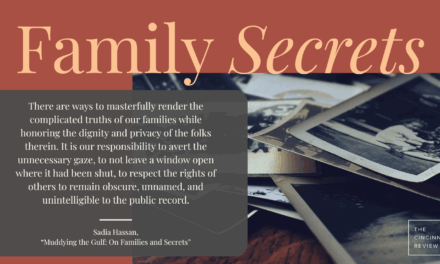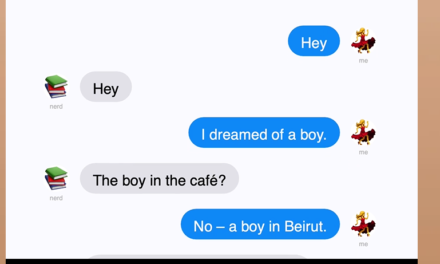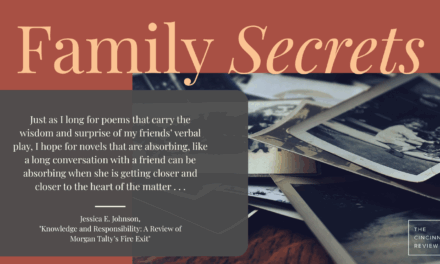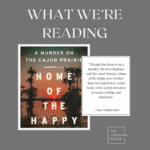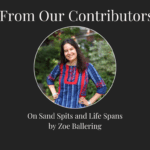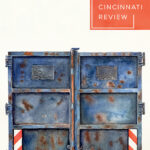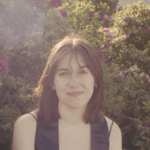13 minutes read time
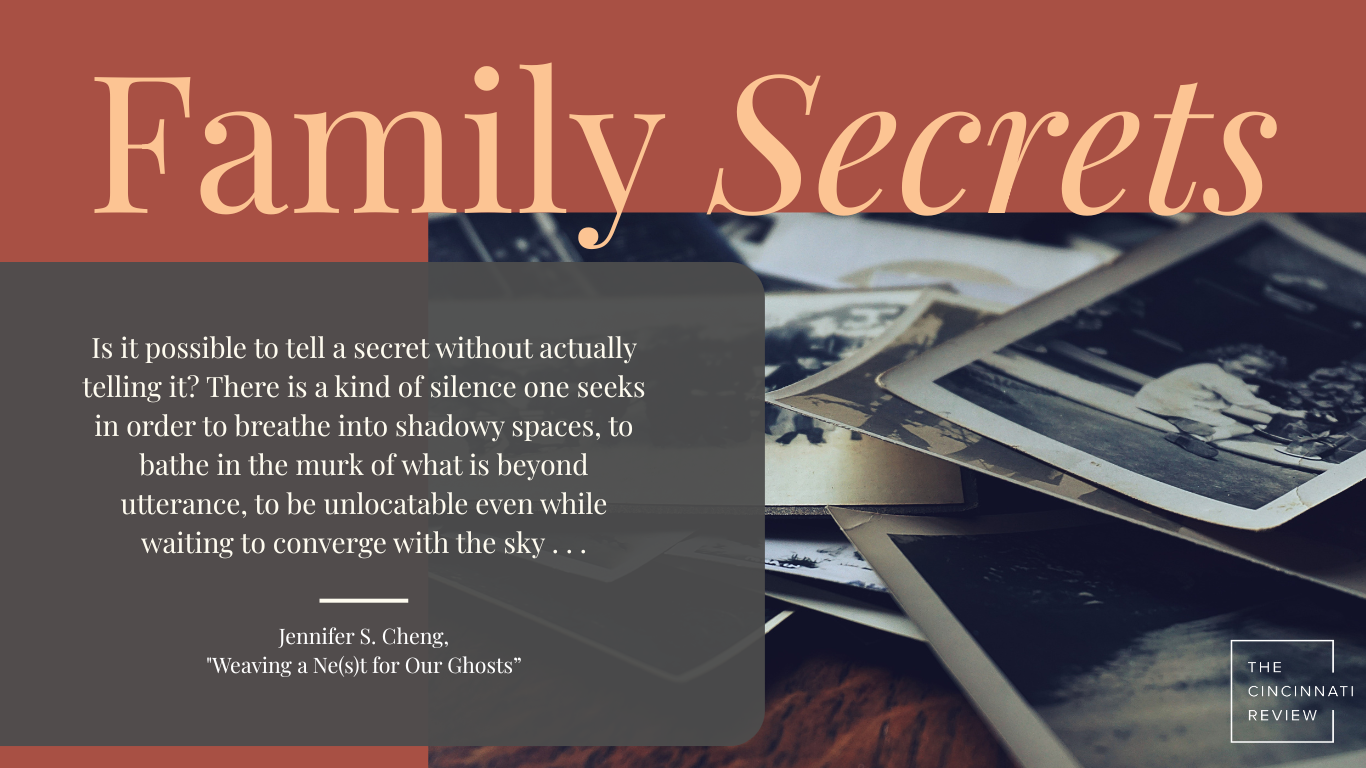
To accompany our spring 2025 issue (22.1), we have curated a folio on family secrets (reviews and craft essays), after noticing that several pieces in the print issue include that theme. Here is Jennifer S. Cheng’s craft essay on writing about family secrets:
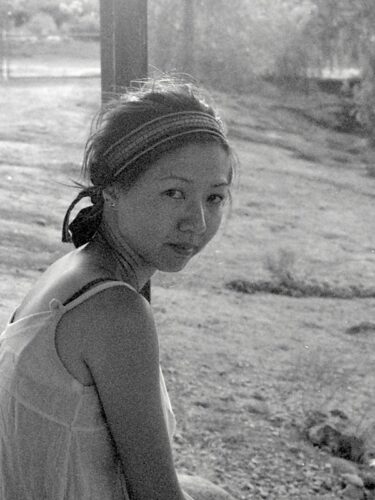
Weaving a Ne(s)t for Our Ghosts
A family is woven by the stories it tells, as well as the stories it doesn’t tell. My work as a writer, especially as an Asian American child of immigrants, often grapples with what it means to grow up in a household haunted by the presence of various absences—untold histories and traumas, missing family members, forgotten lineages, archival gaps, lost vocabularies. So much of what is deeply sensed in the shadows of a home cannot be uttered aloud or even fully known. Instead, these ghosts exist as secret wounds, punctures, apertures in the fabric of daily life. How do we write meaningfully about what we do not know or cannot say?
*
For the diasporic child, language itself can feel like a perforated gossamer textile. In my household the sounds and cadences of multiple dialects wove an intimate, tangled atmosphere that enveloped my body regardless of linguistic understanding—it was as much sensate as it was semantic. The truth is that every child encounters language first as a condensation of texturalities before it becomes anything else. “Words are skeins,” writes Susan Howe.
*
The origins of netting and nesting begin in something primal. To weave a net is to entwine plant fiber and animal tissue into permeable fields that are then submerged into a literal and existential expanse. It is to create a density of textures that can then catch its own density of textures: daydreams, desires, plots, atmospheres, resonances, concordances, encounters. Drift nets, encircling nets, trap nets: each with its own pattern of entanglement and mode of encounter; each a medium for divination. To weave a nest is to build a home, a shelter, amid the tumult of the world. Both nets and nests gather their structures out of surrounding splinters and slivers. Both are openwork constructions: “having a pattern of openings or holes”; “work that is perforated”; “technique that [ . . . ] creat[es] holes, piercings, or gaps [ . . . ] through solid material.” Openwork text, perhaps: With language, I am weaving something of a net and something of a nest, in order to hold, catch, cradle, protect, gestate my hidden interior narrative.
*
In Gaston Bachelard’s The Poetics of Space (Orion Press, 1964; reissue Beacon Press, 1994),he describes a nest as a home made “by and for the body, ” its literal form shaped according to the contours and cadences of its inhabitant. The material constituents of the nest are the entrenched detritus of everyday life. In Edges & Fray (Wesleyan University Press, 2020),poet Danielle Vogel reminds us of the provisional particularities of nest-making: “some nests can only be reached / through a tunnel”; “subterranean burrow”; “arboreal nest”; “a dome of moss built on a cliff’s edge”; “swiftlet catching nesting materials in flight”; “bird-species who pull out their own body hairs and bind them with silk.” She invites us to “start by making a loose ball of words” and then “to press one’s body against this curve.”
*
Of course, a nest is not only a dense buildup of matter; at its literal core it architects a hollow, which is the indentation of the body. Even a wren nest—a nearly enclosed sphere—has a small, strategically placed hole. “[H]ome . . . hole . . . envelope,” Bachelard quotes from Victor Hugo, invoking designations that might also pertain to the openwork text. And the hole that lets out water is also an opening for the bird to enter.
*
In a writing seminar I co-taught with poet and friend Mia Ayumi Malhotra, “The Field Between Us: Poetries of Correspondence and Connection,” I offered a prompt, referencing Vogel: “Let us construct a nest to hold/gestate the hidden interior narrative. Relying on instinct, gather materials toward the matter of the place. What would it mean to ‘press one’s body against this curve’? What form is required to hold the shape of the ‘secret unsayable center’? Where are the openings for the body to enter, and how will the water run out? Consider: intimate debris, atmospheric conditions, acoustics, spatial relationships, contortions.”
*
In The Piano (1993), a film directed by Jane Campion, a nineteenth-century woman who has been mute since childhood for unexplained reasons finds herself stranded with her young child on a windswept beach, the ocean and sky a tumult of bleary light. As night washes in from all directions, the woman fashions a tent out of her corset and undergarments, while the daughter collects white rocks from the coast, arranging them into a bright circle of moons around their makeshift shelter. Only once inside the protected space does the mother share with her inquiring child bits and pieces of her shrouded history, using hand gestures. “These places will inscribe their own topography: make their shape with their shape. And will sonar inside the void,” writes Renee Gladman in Plans for Sentences (Wave Books, 2022).
*
Is it possible to tell a secret without actually telling it? There is a kind of silence one seeks in order to breathe into shadowy spaces, to bathe in the murk of what is beyond utterance, to be unlocatable even while waiting to converge with the sky: “a nest is a hiding-place for winged creatures,” says Bachelard. In my own relationship with language, my compulsion toward articulation is inseparable from my compulsion toward silence; so entangled are their functions and longings, they act as one. In Poetics of Relation (University of Michigan Press, 1997), philosopher and theorist Édouard Glissant argues for the “right to opacity” in resistance to the authoritative and possessive desire to understand and know the other. “Opacities can coexist and converge, weaving fabrics,” he writes, “To understand these truly one must focus on the texture of the weave . . . What is here is open, as much as this there . . . This-here is the weave, and it weaves no boundaries.” This, here, I think, offers a kind of textual refuge, where the correspondences and connections being woven are not enclosures but rather openings—they are texturalities of relation.
*
Netting: a “method of constructing open fabrics by the crossing of cords, threads, yarns, or ropes so that their intersections are knotted or looped, forming a geometrically shaped mesh, or open space.” By weaving together shapes of air, interlacing gaps and openings, spinning a map of little voids, one can conjure a field of resonances. In linguistics and physics—formal studies of language and matter—one learns about the preponderance of empty space. It is the gaps between words that are the connective tissue, where meanings reside. It is the cosmic voids between galaxy filaments that make life possible—a physical void is not actually nothing but instead a field of potential.
*
Indeed, if the work of the poet is, as Rosmarie Waldrop suggests, to “gap gardening,” how then might we lean into this as writers of what is secret, ghostly, elusive, obscured, unknown? For at the heart of a ghostly presence is its punctum, which, to borrow a concept from Roland Barthes, is the part that pierces and punctures and can only be poignantly sensed. What makes the ghost unsayable—its wound, its punctum—is also the source of its power. Says Waldrop: “The gap causes sparks to fly[;] connection, relation, makes for things happening. The edges give off sparks.”
*
Perhaps to weave a net as a writer is to converge language-matter into lines of flight, passageways of possibility. In a net, the knots and holes define and depend on one another—an inextricable collaboration of oppositions that accounts for the weave and that gives the structure its necessary flexibility and permeability. After all, language is a balance of sound and silence. Together the intersections and openings configure a network of thresholds, seams, interstices. In architecture and anthropology, thresholds by definition are liminal spaces of flux, uncertainty, and paradox, which open the opportunity for transformation. What vital and unfathomable transfigurations are made possible when we weave for our ghost or hidden narrative a shifting field of arrival and departure, presence and absence, sound and silence—porous, so as to let the light in?
*
It’s true that my interest in nets/nests is largely owing to their structural reliance on negative space—a formal element I examined in another essay, “Dear Blank Space”—but what specifically compels me is how the gaps alchemize with the gathering by way of an embodied practice of mundane yet profound repetition. When Emily Dickinson writes, “Emerging from / an Abyss and / entering it again—/ That is Life, is / it not?,” I cannot help but think of how this echoes the pattern of a net, the recursive motions of weaving. The process itself engages an ongoing dialectic that creates itself with each iteration. “Language is migrant,” says artist Cecilia Vicuña, and indeed the act of weaving follows a gradual path of accretion, whereby a vast geography is created as it is being followed. “These sentences will wind tightly around who we are and how we live and will grow habitations as they wonder,” affirms Gladman. Far from an inattentive capitulation, however, to garden the gap, to weave an open field of shifting relations, requires a deeply oriented, tender, even domestic attention—a faithful ritual of small returns and remembrances, as the body listens closely for where each movement leads next. It is an attunement that also means surrender, like walking a sacred labyrinth, and meanwhile a vast topography of engagement, encounter, and habitation is slowly revealed.
*
In Ruth Asawa’s openwork sculptures of woven wire, she creates interlocking and multilayered forms within forms that are delicate and feminist, industrial and labor intensive. The first time I saw her hanging sculptures of woven shapes within woven shapes, and the intricacy of shadows invoked by the overlapping patterns of negative space, I immediately thought: “Oscillating wombs.” The sculptures are both net and nest,porous structures that cast a space while also sheltering an interior space. Anne Anlin Cheng describes “the sinuous, intricate continuity of the wire” as “creat[ing] worlds within and without, turning interiority into exteriority and vice versa, transforming containment into exposure and back again.” The only way to see the interior sculptures—the forms within forms—is through the lattice of negative space surrounding and enveloping them. Asawa speaks of her process in terms of calligraphy: “You’re not watching what your brush is doing, but you’re watching the spaces around it. You’re watching what it isn’t doing, so that you’re taking care of both the negative space and the positive space.” Such careful stewardship of what isn’t there makes for a miracle where negative and positive, interior and exterior, merge into something else, moving and mysterious. Bachelard: “A house that shines from the care it receives appears to have been rebuilt from the inside; it is as though it were new inside.”
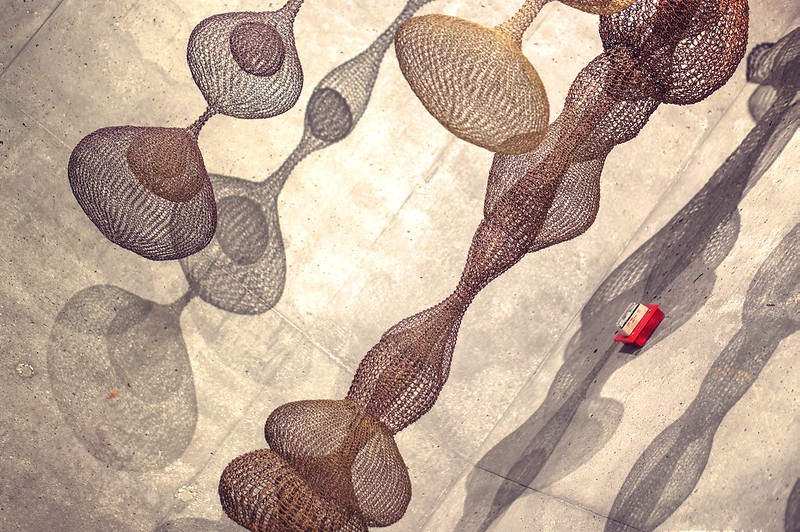
*
What might it mean for a writer of the ghostly not only to acknowledge the negative space but to tend to it, to follow their punctum and care for their emergent scapes? How do the perforations, absences, and silences in our constructions mediate and allow us to glimpse the hidden interior narrative of the ghost? What texturalities of relation are revealed through a process of embodied architecture, accumulative articulation, iterative attunement?
*
My first book, House A (Omnidawn, 2016), invokes the haunting of various histories—personal history, familial history, History—and explores how that which is unnamed and taboo inside a household still inscribes itself onto the body. The book begins with a series of epistolary prose poems addressed to the looming figure of Mao Zedong, weaving an evocative field of textures from the motes and specks of a child’s life and consciousness. I write to Mao in associative leaps about, around, and through intimate ephemera that seem to have nothing to do with him: the feeling of sleep, tidal rhythms, afternoon sunlight on the carpet, bare feet against linoleum, deep-sea creatures, rice porridge boiling over . . . The language follows a kind of syntactical or rhetorical music, and in between sentences and poems are chasms, ruptures of linearity and logic. I know now that I was casting a wide net porous enough to capture all the entanglements without parsing them, instead allowing the uncertainties, silences, and ambiguities to press their shape against the curve, to perforate and permeate the weave, to create openings in the text for unforeseen correspondences and resonances. It felt like the truest, most texturally and emotionally precise utterance I could ever make.
*
For we live our lives amid the residue of familial ghosts and unsayable secrets, and what if our most fundamental agency lies in the composition, in how we arrange the debris left in their wake? We weave a net of presences and absences, and sometimes it brings us home in a way we could not have anticipated. We gather traces and echoes of precarities, longings, apocalypses, dreams, and through an attuned, accretive process of unexpected affinities and correspondences, we create a vast fabric of attention; an emblematical map at once textural, contextual, and relational; an open field of shifting constellations in which to meet our hidden narratives and therein rescue them.
Sources:
Bachelard, Gaston. The Poetics of Space. Beacon Press, 1994.
Cheng, Anne Anlin. “From Tool to Ornament.” In Ruth Asawa: Retrospective, edited by Janet Bishop and Cara Manes. Yale University Press, 2025.
Cheng, Jennifer S. “Dear Blank Space: A Literacy Narrative,” Literary Hub,Dec. 26, 2022.
Cheng, Jennifer S. House A. Omnidawn, 2016.
Cheng, Jennifer S. and Mia Ayumu Malhotra, Creative Writing Seminar: “The Field Between Us.” The Ruby,Spring 2022. *
Gladman, Renee. Plans for Sentences. Wave Books, 2022.
Glissant, Édouard. Poetics of Relation. Translated by Betsy Wing. University of Michigan Press, 1997.
Howe, Susan. Spontaneous Particulars. New Directions, 2014.
Naimon, David. “Between the Covers: Rosmarie Waldrop Interview” (podcast transcript). Tin House, n.d.
“Netting,” Britannica.
“Openwork,” Collins Dictionary, Merriam-Webster Dictionary, and Wikipedia.
Vicuña, Cecilia. “Language is Migrant,” Poetry Foundation. April 18, 2016.
Vogel, Danielle. Edges & Fray. Wesleyan University Press, 2020.
*Note that the title comes from Molly McCully Brown and Susannah Nevison’s In the Field Between Us: Poems. Persea Books, 2020.
Jennifer S. Cheng is the author of award-winning hybrid books Moon: Letters, Maps, Poems (Tarpaulin Sky, 2018) and House A (Omnidawn, 2016). Her writing appears in The Atlantic, McSweeneys, Tin House, and elsewhere, and has received support from Brown University, the University of Iowa, National Endowment for the Arts, the U.S. Fulbright program, Bread Loaf, MacDowell, and the Academy of American Poets. Having grown up in Texas and Hong Kong, she lives in San Francisco. More at www.jenniferscheng.com.

